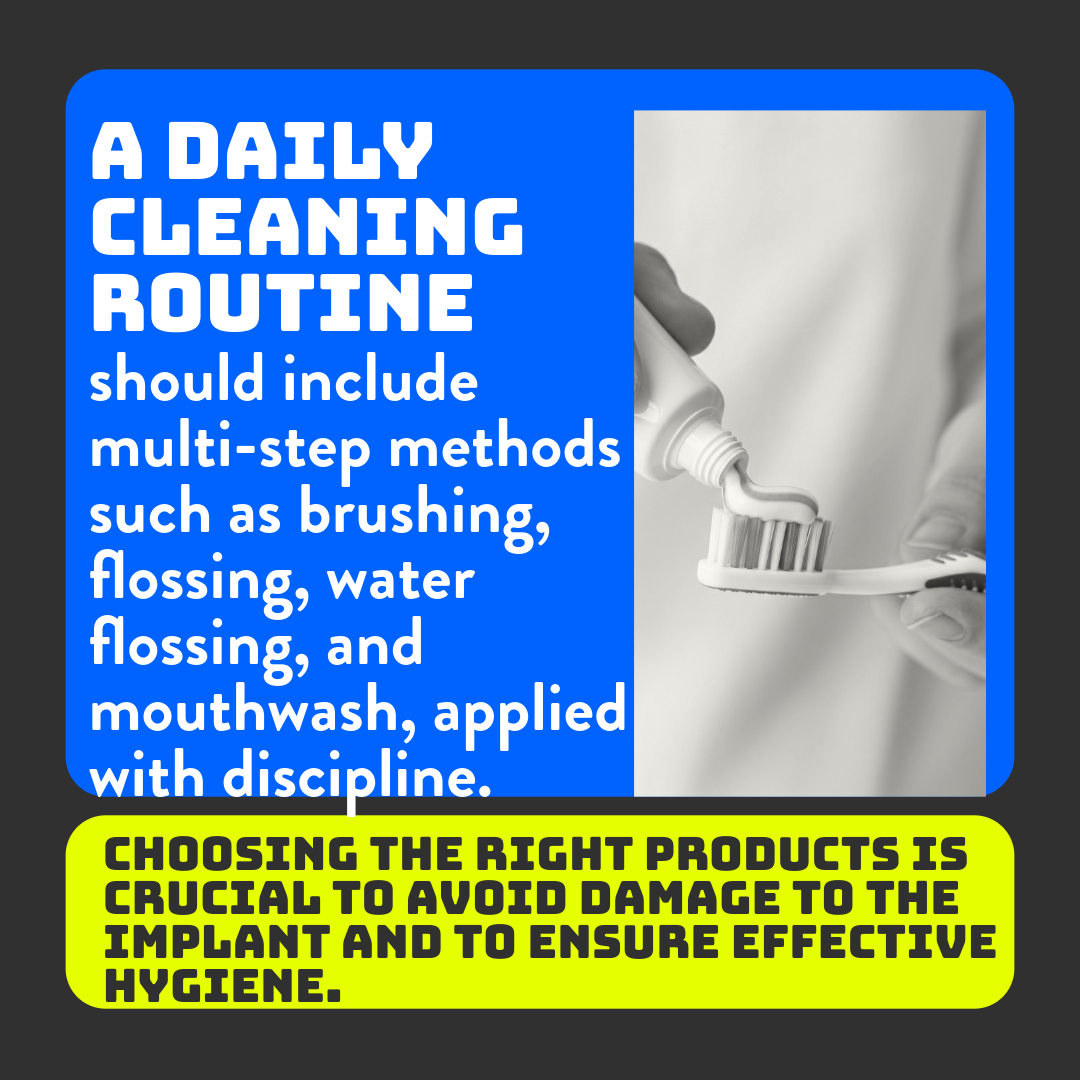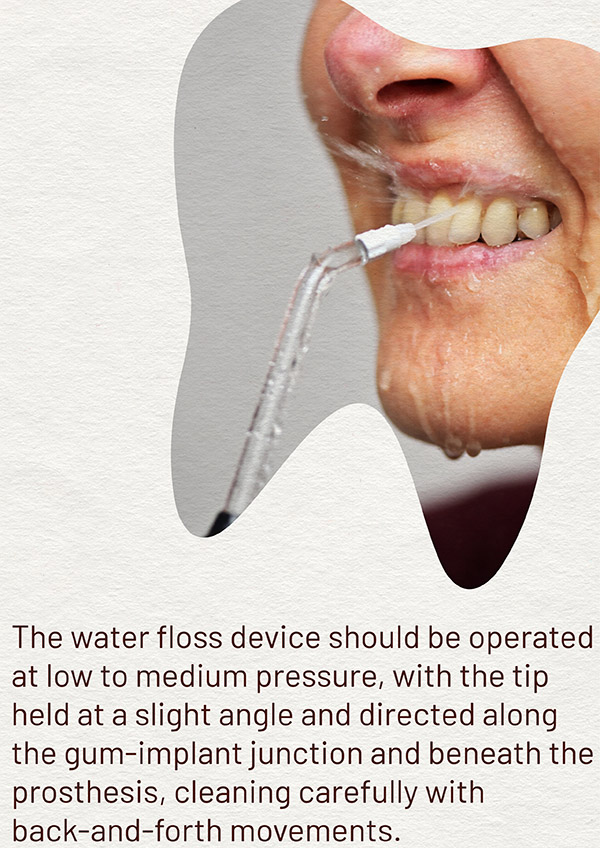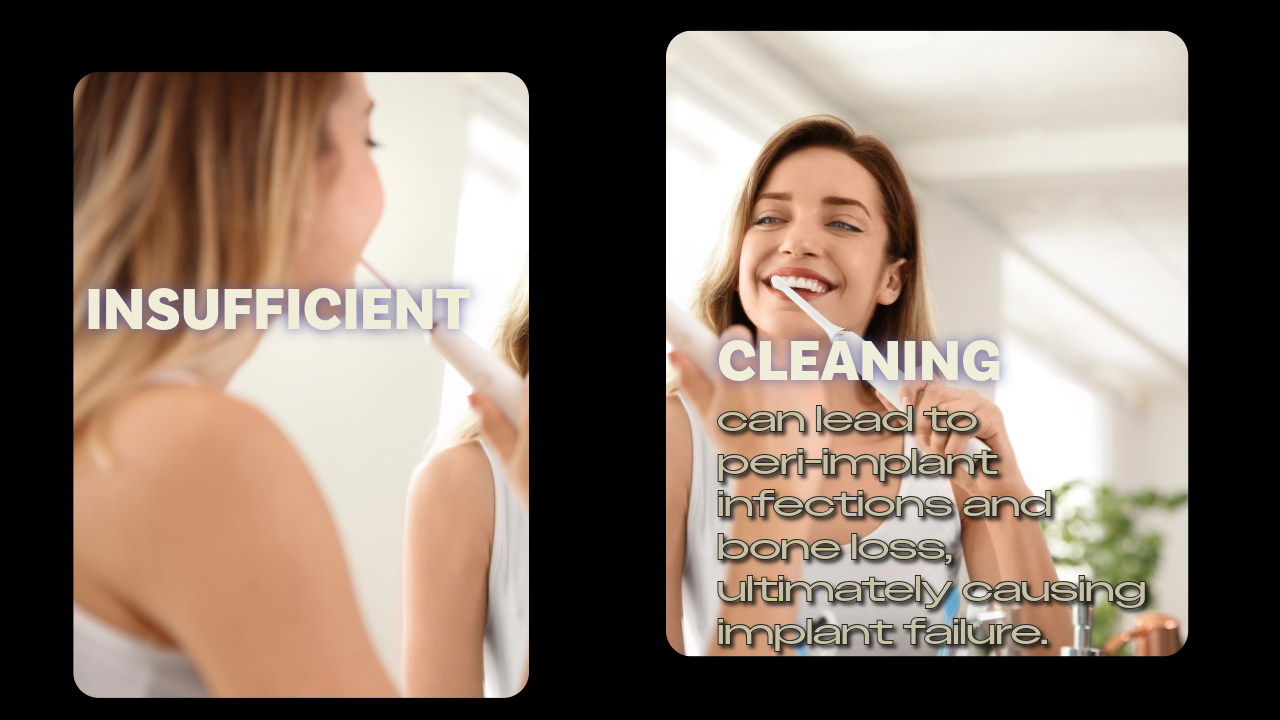Dental implants can only last as long as the bone and soft tissues that support them do. Therefore, regular and effective cleaning of the implants and the surrounding peri-implant tissues is critical for maintaining biological integration and prolonging the functional life of the implant.

In fixed full arch restorations, micro gaps may occur between the implants and soft tissues. It is also possible for food particles, dental plaque, and microbial biofilm to settle on the prosthesis's underside. If these deposits are not removed regularly, chronic low-grade inflammation may develop around the implant. This could cause bone loss and eventual implant failure if left untreated, eventually progressing to peri-implantitis and peri-implant mucositis.
Daily Cleaning Routines
By maintaining proper oral hygiene and preventing food residues from building up under All-on-4 prostheses, you can extend the life of your implants and maintain good oral hygiene overall.

Tooth Brushing (Morning and Evening):
The dentures on the implant and your teeth should be brushed at least twice a day, after breakfast in the morning and before bed. Using a soft-bristled toothbrush, brush all surfaces of the dentures with circular and gentle movements. Remove plaque build-up, paying particular attention to the gum line (the area where the gum meets the denture). Also, try to clean the areas close to the bottom of the denture by keeping the bristles inclined. Be careful not to press too hard when brushing; a gentle but careful brushing both removes plaque and does not damage your gums. Gently brushing your tongue and the inside of your cheeks can also reduce oral bacteria.
Flossing or Interfacial Cleaning:
Flossing at least once a day, especially in the evening, is essential for areas that the toothbrush cannot reach. You can use special dental floss or threaders to floss all-on-4/6 prostheses. In this way, you can pass the floss under the prosthetic bridge and clean the debris around the implants. Gently remove plaque with up-and-down movements by resting the thread against the body of the implant and grasping it sideways in a C-shape. If traditional flossing is difficult, interdental brushes (small-tipped brushes) are also effective in cleaning between implants. Place an appropriately sized interdental brush between each implant and ensure that the accumulated debris is removed by reciprocating movements.
Cleaning with Water Thread (Mouth Shower):
Water flossers, also known as mouthwash, are a powerful aid for All-on-4 and All-on-6 users. Adding a water flosser to your daily routine is especially useful for cleaning areas that brush and floss cannot reach. Remove food debris and plaque by directing the water jet of the mouthwash device towards the joints of the implants, the gum line and under the denture. The water pressure helps to remove debris accumulated under the bridge and increases blood circulation by massaging the gums. You can preferably do this every evening before or after flossing. Since the mouthwash provides cleaning in addition to flossing, it works best to use both methods together.
Rinsing with Mouthwash:

After brushing and flossing, complete the cleaning by rinsing your mouth with an antibacterial mouthwash. An antiseptic or fluoride mouthwash (make sure it is alcohol-free) will help kill bacteria left over from brushing and flossing. When gargling, swish the liquid around your mouth and ensure that it comes into contact with the areas around the dentures. Rinse and spit for about 30 seconds, no need to rinse again with water (unless otherwise stated in the product instructions). Regular use of mouthwash reduces the formation of bacterial plaque, prevents bad breath and promotes gum health.
This daily routine consists of simple steps that will take a few minutes in the morning and evening. Once you make it a habit, it will be much easier to maintain the health of your implants and gums. Remember, regular and correct cleaning is the most guaranteed way to extend the life of your implants.
Products Used in All-on-4 Cleaning:
Using the right cleaning products in the maintenance of All-on-4 and All-on-6 dental implants systems contributes significantly to the effective provision of oral hygiene and the long life of the implants. The main products you can use for this are as follows.

Soft Bristle Toothbrush:
Use toothbrushes with soft or extra soft bristles for cleaning implant-supported dentures. Hard brushes can both damage the prosthesis surface and irritate the gums. Manual brushes will do the job; you can also use electric toothbrushes if you wish. The vibrating movements of electric brushes can be effective in plaque removal, but make sure that they still have a soft head. Remember to replace your brush about every 3 months or when the bristles become deformed.
Non-abrasive Toothpaste:
When cleaning All-on-4/6 dentures, choose a toothpaste that does not contain highly abrasive particles (e.g. avoid toothpastes with very strong whitening action). Standard fluoride toothpastes are usually suitable and help to strengthen your gums. Choosing products with gentler formulas will preserve the aesthetics of your denture, as abrasive pastes can scratch and dull the surface of the denture.
Dental Floss and Threaders:
Conventional dental floss can be used to clean around implants, but special types of floss make it easier for All-on-4 and All-on-6 dentures. Floss designed for bridge and implant care (such as "under-bridge floss" with a hardened tip) can be easily threaded under the prosthesis. Alternatively, you can guide normal dental floss under your implant bridge using a floss threader. This tool allows the floss to reach under the prosthesis with the help of a needle, making it possible to clean areas that cannot normally be reached.
Interdental Brushes:
Interdental brushes are very useful for cleaning narrow areas around implants. These small brushes are available in different thicknesses and are ideal for removing plaque close to the gum line, especially in fixed prostheses with multiple implants, such as All-on-6. By gently inserting the brush into the space between the implant and the prosthesis and moving it back and forth, you can remove accumulated food debris and bacteria. The thickness of the brush is important here: A brush that is too thick cannot get into the gap, while a brush that is too thin cannot provide sufficient cleaning. Your dentist will decide which size is right for you.
Mouth Shower (Oral Irrigator):
Water-pressurised oral irrigators are recommended as an adjunct or alternative to flossing. These devices clean between teeth and under dentures by spraying water in a fine jet. Especially for those who have difficulty flossing, mouthwashers offer a practical solution. Every day, you can put warm water (optionally, an antiseptic solution recommended by your dentist can be added) into the water tank and use it at low-medium pressure to remove plaque. You can minimise tartar and bacteria accumulation by holding the tip of the mouth shower at a slight inclination, not at a 90-degree angle to your gum, and moving it around the implant.
Technique of use:
Start the mouth shower at low pressure (e.g. setting 2 or 3) and adjust to your comfort zone. Guide the tip into the space between your gums and the bridge. Clean by moving it along the gum line and spraying your teeth thoroughly. Focus especially on the underside of the hybrid denture and areas where small food particles get trapped. Clean the joint under the denture twice, moving back and forth and sideways, like brushing.
Tip Selection:
Although most mouthwashes come with 5-7 different tips, it is recommended that you only use the standard tip and the hook/implant prosthetic tip. The standard tip is used for the exterior, while the hook tip is particularly useful for cleaning the interior, such as the frontal area of the lower jaw; this tip allows you to hold the mouthwash on the outside of your mouth to clean the inside comfortably.
Antibacterial Mouthwash:
It is recommended to use an antibacterial or antiseptic mouthwash to support your daily oral care. Alcohol-free mouthwashes fight bacterial plaque without drying out the oral tissues. Especially mouthwashes containing chlorhexidine may be recommended by the physician when short-term intensive care is required (for example in the post-surgical period), but fluoride and milder antiseptic mouthwashes should be preferred for daily use. Using mouthwash reduces the risk of gingivitis by killing bacteria that you cannot reach with brushing and flossing and provides a fresh breath.
Professional Cleaning and Controls
Despite your meticulous care at home, regular dental check-ups and professional cleaning are essential to maintain the health of your All-on-4 and All-on-6 implants. Generally, one check-up is recommended in the first 6 months after implant treatment, after which routine check-ups and cleanings are recommended every 6 months (twice a year). The purpose of these visits is not only to clean, but also to take precautions by catching any signs of problems early.
Implant and Denture Check:
Your dentist or dental hygienist will first examine the gum tissue around the implants and the general condition of the denture. The gums will be checked for redness, swelling, bleeding or tenderness. This examination also reveals how well you are able to carry out your daily care; if necessary, the specialist will remind you of the correct cleaning techniques and point out any deficiencies. In addition, the stability of the implants will be assessed by hand and, if necessary, by means of small x-rays to check for any play or changes in the bone level.
Professional Cleaning:
After the check-up, a detailed cleaning is carried out in the clinical environment with specialised instruments. If necessary, your dentist can remove your fixed prosthesis (especially if it is screwed) and completely expose the areas under the prosthesis. In this way, tartar (calculus) and plaque accumulated under the denture are removed with the help of special scraping instruments and ultrasonic cleaners. After the tartar around the implant is removed, the denture is reinserted and the surfaces are polished. This professional cleaning process completes your oral hygiene by removing residues that you cannot reach or do not notice at home. Especially tartar that has not been cleaned for a long time can only be completely cleaned with professional intervention.
Conclusion
All-on-4 and All-on-6 implant treatments improve the quality of life of patients by providing a comfortable and permanent solution to the problem of complete edentulism. However, the long-term success of this advanced treatment method largely depends on the patients' own oral care discipline. With the right cleaning habits, your implant-supported dentures not only provide an aesthetic smile, but also a healthy oral environment.
When cleaning difficult areas, do not neglect to check them at the same time. Clean in front of a mirror, if possible in a well-lit environment. Check the line where the prosthesis meets the gum line; if you notice redness, swelling or bleeding with brushing, this may indicate areas that have not been cleaned thoroughly. In these cases, take a little more time and gently clean the area again. If you feel that there are deposits that you cannot reach despite regular cleaning, ask for advice on specialised cleaning at your next visit to the dentist.
In addition, regular dental check-ups and professional cleaning sessions should not be neglected. Check-ups every six months are of great importance both for the early detection of problems that you may not realise and for reinforcing your cleanliness at home. Your dentist will monitor the health status around your implants and intervene when necessary to prevent serious problems from occurring.
Frequently Asked Questions
Below you will find frequently asked questions and answers regarding cleaning methods for all-on-4/6 implant systems.
What is the best toothpaste for All on 4 and All on 6?
For All-on-4 or All-on-6 dentures, it is important to use a non-abrasive paste that targets sensitive teeth. Normal pastes can scratch and dull the denture surface, so low-abrasive formulas are recommended. In the period of temporary dentures, a baking soda-water mixture should be preferred. When switching to permanent dentures, paste can be used with peace of mind for freshness, because fluoride is not required.
How to clean a complete set of dental implants?
Brushing twice a day for at least 2 minutes each with a soft bristle brush, reaching around the implant with Super Floss or an interface brush and cleaning between the denture and implant with a mouthwash (Waterpik etc.) form the basis of the home routine. In addition, regular use of antibacterial mouthwash and professional examination + radiography every 6 months are critical for the long life of the prosthesis.
Does food get under the denture?
Yes, small pieces of food can accumulate because there is a slight gap between the denture and the gum. Regular use of mouthwash is therefore recommended. The design of the denture also directly affects its cleaning; poorly designed dentures can increase food build-up.
What should be the daily cleaning routine?
For the first 3 days after the operation, only Stella Life gel/wash/spray and warm saline should be used, as well as gentle cleaning with Monajet syringes. After the first week, very gentle brushing with a baby brush and baking soda paste is started. With a permanent prosthesis, a routine of normal paste, brushing twice a day, mouthwash, Super Floss and mouthwash is started. Professional care should also be repeated every 6 months.
How to clean with a waterpik (mouth shower)?
Start with low pressure and spray water along the implant-gum junction and under the denture. The standard tip is used for the anterior and external surfaces, the hooked tip is used to reach the inner areas. At least twice a day; some patients prefer it after every meal. It is an indispensable complement to denture cleaning.
Is cleaning costly?
Home remedies (Super Floss, mouthwash, specialised brushes) are moderately costly and budget-friendly. It is best to contact the clinic directly to find out the cost of professional cleaning + check-ups.
How are permanent (non-removable) implants cleaned?
The same routine applies as for all-on-4/6. Permanent prostheses can only be removed and thoroughly cleaned by the dentist. The technique includes daily brushing, flossing, mouth rinsing, mouthwash and semi-annual professional care.
Does food trapped under the denture cause infection?
Yes, plaque and bacteria accumulate in areas that are not cleaned, preparing the ground for inflammation and infections. In some types, such as zygoma implants, this becomes even more risky if the water shower is used incorrectly.
What happens if cleaning is not done?
Food/plaque accumulates, increasing the risk of bad breath, inflammation, pus, peri-implant bone damage and implant loss. In addition, the surface of the prosthesis can be scratched and stained, and poor cleaning by design can lead to serious complications.
